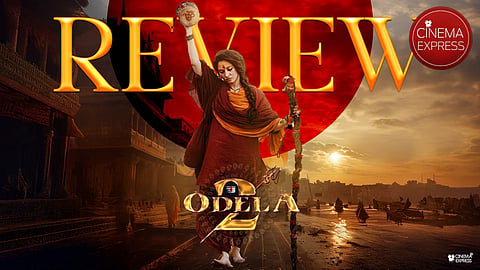Odela 2 Movie Review: A spiritual horror film that’s less horror, more havoc
Odela 2 movie review (1.5 / 5)
There’s a poster of Odela 2 where Tamannaah Bhatia’s character walks on skulls. Those skulls might belong to the audiences who stepped out of the test screening of this film. There's a special kind of cinematic exhaustion from films like Odela 2, the kind that can make even the most cacophony-craving spiritual audiences breathe a sigh of relief after the film’s screening. Marketed as a spiritual-horror sequel to the passable crime-thriller Odela Railway Station, this film is less a narrative and more a buffet of recent genre trends thrown into a blender with the lid off. Directed by Ashok Teja and “supervised” by Sampath Nandi, Odela 2 is what happens when a film sets out to be everything and ends up being nothing but loud.
Director: Ashok Teja
Screenplay and direction supervision: Sampath Nandi
Cast: Tamannaah Bhatia, Hebah Patel, Vassishta Simha, Murali Sharma
The premise had potential, albeit of the outrageous kind. A rapist-turned-murderer-turned-ghost (the worst of its kind) named Tirupati (Vasishta Simha) is entombed in a Samadhi by his villagers, instead of being cremated, to take revenge for the atrocities he committed and deprive him of any moksha (salvation). As women begin to fall prey to his violent ghost once again, the villagers seek help from Bhairavi (Tamannaah), a divine Naga Sadhu and the estranged sister of Radha (Hebah Patel). The story follows her return to Odela and her spiritual confrontation with the spirit. One hopes for catharsis, heroism, or at the very least, a sane storyline. One gets none. May God save the one.
To give the devil its due, the first few minutes of Odela 2 suggest something atmospheric. The cinematography sets up a spooky tone with respectable flair. The transition from grounded crime thriller to full-fledged horror fantasy is done with some narrative patience. There's even a visual nod to the first film with a striking opening scene that turns tables with some intrigue. But before long, the film surrenders to what can only be described as thematic whiplash.
It becomes apparent that Odela 2 is not a film with a voice; it’s a mish-mash stitched together from other voices. From Arundhati’'s horror structure to Akhanda's spiritual swag, from Mangalavaraam’s erotic tension to Virupaksha’s occult rituals, and even a whiff of Hanu-Man’s mythological muscle, Odela 2 is a stew of second-hand ideas strung together with zero understanding of flavour or balance. It’s as if the writers binge-watched a year’s worth of hits, scribbled the most viral tropes on a whiteboard, and then just filmed it.
Worse than its derivativeness is the film’s distressing relationship with sexual violence. Tirupati’s ghost doesn’t merely kill; he rapes and murders, and the film stages these acts repeatedly, with distasteful sensuality, under the guise of storytelling. Sure, villains must be shown in their brutality; indeed, I agree and appreciate gore when made well with craft. But Odela 2 has indulgence, seemingly revelling in these moments for provocation rather than impact. There's edgy cinematic titillation, and then there's subtle carnal tension. This is neither edgy nor subtle. It’s just an exhausting B-grade nightmare. The film's horror comes not from its monster but from the filmmaker’s perspective, and disturbingly, one is not surprised because one saw the first part. May God save the one again.
Post-interval, Odela 2 descends into something even more exasperating: spiritual cosplay without conviction. Tamannaah’s Bhairavi arrives with all the Naga Sadhu aesthetics you could ask for—no make-up (of course this is cinematic no make-up, not the real thing), a stick, and an empty face—but the character remains woefully underwritten. Her introductory scene, where she beats up men harming cows, is likely meant to symbolise strength. But that’s all we get. Her arc, if one can call it that, is reduced to passive participation in an increasingly absurd battle of good versus evil. By the end, we expect some heroism from her character. (This is where a film like Arundhati was powerful). Despite no heroism, the climax asks her character to “submit” to the ghost’s lust to defeat him, using street slang with words like paaducheyyadam (spoiling her). Forget horror and women empowerment themes, It’s hard to tell if all these writing ideas were even meant to be spiritual in any form. Because they land firmly in the “what on earth were they thinking” category.
Tamannaah, to be honest, has very little to do here. She’s a prop in her own story. There is no transformation, no spiritual arc, no rising tension. The performance is flat, not entirely by fault of the actor, but by the design of a screenplay. And I am still baffled about what made the makers promote this film as empowering an actor like Tamannaah by showing her in a deglamourised, performative character. She did far better in many of her previous films. Here, she just murmurs a couple of mantras in Sanskrit (because the dubbing artist did most of the heavy lifting) and has a steady, expressionless face.
Ajaneesh Loknath’s much-hyped score is another casualty of this chaos. Rather than enhancing tension or emotion, the music becomes an assault, blaring through scenes. This is neither music nor intelligent sound design; this is like a malfunctioning car theft alarm. There’s never been a moment of cinema viewing where I pitied myself for watching a film in Dolby Atmos. If horror is about silence, dread and build-up, Odela 2 believes in doing the exact opposite: volume as mood. Sure, this is a consistent problem in most commercial outings recently, but that’s a topic for another day.
There are, however, glimmers of nuance. A character from another faith is handled with dignity (Again, it reminds too much of Sayaji Shinde’s character from Arundhati). And there’s an engaging VFX sequence where the ghost controls all the elements of nature. It has been executed impressively, granting the film some scale. But these are crumbs and not nearly enough to justify the exhausting 150-minute runtime.
Films like Odela 2 are not rare anymore. They are a symptom of a larger malaise, the belief that genre can replace narrative, that aesthetic VFX can mask lack of character design, that loud sound is sufficient to elevate a scene and that spiritual themes are enough to carry the weight of emotional truth. In a film like Virupaksha, with a similar supernatural antagonist, there was a brilliantly done emotional love story that connects the whole mystery together. There is nothing to root for in this film, and that’s the bigger problem and a sign that if there is any evil, it is in this screenplay.
If you're a devotee of the films Odela 2 so desperately mimics, perhaps there's something here for you. There are fleeting elements of engagement in its Lord Shiva-themed scenes towards the climax. But for most viewers, this is less a horror movie and more a test of tolerance. Regardless, the film even has the audacity to declare another sequel. Only God might be able to save us from Odela 3 when it arrives.
P.S. Ultimately, one feels not frightened but fatigued. As the theatre lights come on and the overbearing score finally stops, it’s hard to tell whether you're walking out of a movie or recovering from a fever dream.


